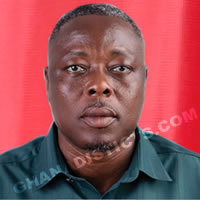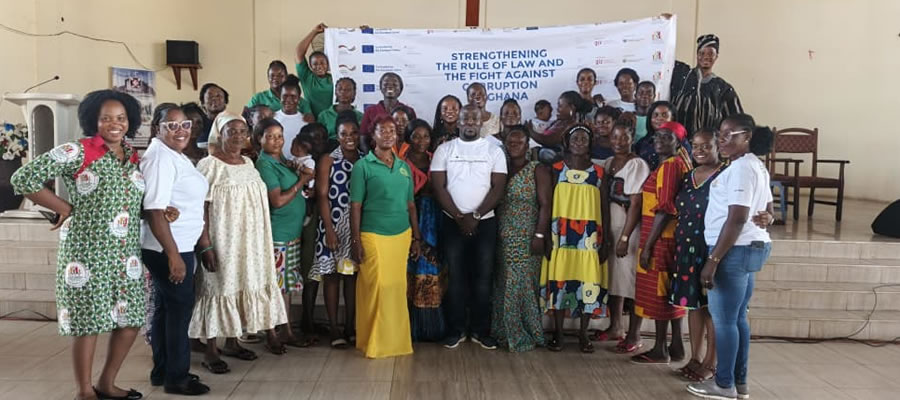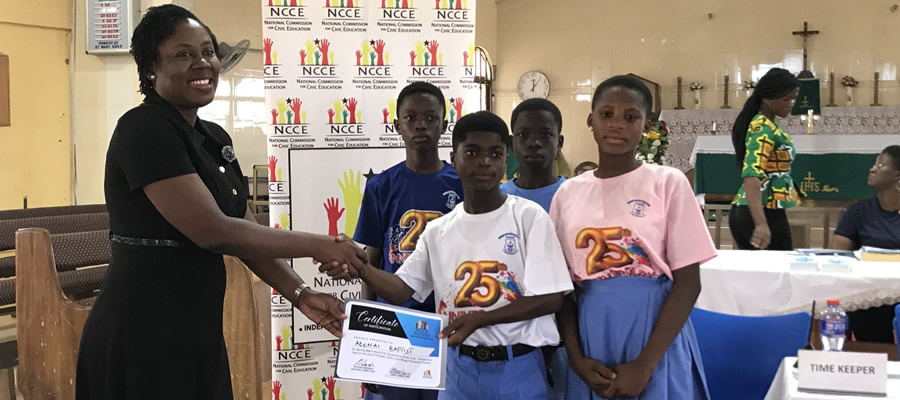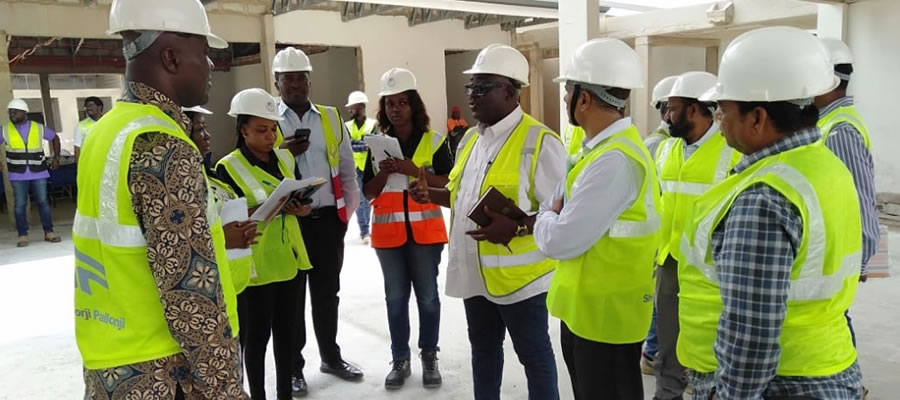

Transport, telecommunication and banking services
The district has about 264.9 kilometers of road network. 40 per cent is surfaced while the rest are feeder roads. The road surface condition of the national trunk roads (i.e. Tema–Akosombo and Tema-Aflao) is of an appreciably good condition. Various forms of transport including private vehicles, commercial private minibuses, public buses, motorbikes, tricycles, bicycles and others types of IMTs are found in the district.
The district is earmarked for the construction of a new Ghana international airport, Ghana affordable housing and an ultra-modern sports academy among others.
The new international Airport is one of the major interventions of the government, intended to ease pressure on the Kotoka International Airport (KIA) and create more space for Airlines in the country. A land size of 60,000 acres has been acquired at Tsopoli-Nigbenya a community within the district for this project. So far, feasibility study and survey works had been completed on the project and work will soon begin. The project will be jointly funded by the government of Ghana and other investors. The Airport will come along with new state Airlines. It is expected that this project will bring development, create employment and other economic benefits for the people in the Ningo-Prampram district and Ghana at large.
The Ghana (5,000) affordable housing unit is under construction in the Ningo-Prampram district. This initiative is to help solve the housing deficit in the country and also provide employment for the local contractors and the people within the district. The amount being accrued in the sale of the houses would be channeled into building additional houses for the district and the country at large. (Source: Ghana News Agency)
Availability of cheap agricultural lands is forcing private housing developers (Castle Gate, Elite Kingdom, HFC Reality, Noble Reality Estates etc.) into converting the district into dormitory towns for workers in and outside the district.
The district is served with a number of services which includes banking, transport, telecommunication, and electricity. There are Fourteen (14) financial institutions, sixteen (16) fuel service stations and eight (8) Gas stations. The district is connected to the national electricity grid. Current estimates show that more than half of households in the district have access to electricity.
Introduction
Social Characteristics
Ghanaian households reflect social structure, in that living arrangements are largely influenced by socio-cultural factors, such as, marriage, types of family and kinship systems existing in a particular society. The structure and composition of households differ among the various ethnic groups in Ghana. It is important that the household composition and distribution of any population be analyzed to facilitate development planning, programmes and policy implementation. With the current decentralized governance system and administration of planning in Ghana, it is important that statistics be provided on the household composition and structure, nationality, literacy, educational status, marital status, ethnicity and religious affiliation of the population in Ningo-Prampram district.
Size, Household Composition and Structure
The composition and structure of households are influenced by social, economic and demographic factors while the total size of a population and its characteristics are largely a reflection of what pertains at the household level.
Household Size
Table 3.1 provides information on household size by locality in the NingoPrampram District. The District has a household population of 68,521 with a total number of 14,627 households. The average household size from the 2010 PHC data in the District is 4.8 persons per household. The average household per house is 1.6 with urban dwellers having a higher proportion of households per house than rural dwellers. However, average household size for rural areas (5.4) is higher than urban areas (4.3).
Household composition and headship
Table 3.2 shows household composition and headship in the district. The total household population is 68,521 of which males are 47.2 percent and females 52.7 percent. The highest proportion of the household population are children (37.9%), followed by heads (21.3%), grandchildren (13.5%), other relatives (9.2%) and spouses (8.4%). Among male household population, 39.1 percent are children compared to 36.8 percent among female household population; 25.1 percent among male household are heads compared to 18.0 27 percent among female household population are heads compared and 14.1 percent of male household population are grandchildren compared to 12.9 percent among female household population. There are higher proportions of parent/parent in-law and son/daughter in-law among females in household population (1.1% and 0.8%, respectively) than they are among male household population (0.3% and 0.3%, respectively).
Household structure and sex
Household structure is a classification of ties of affiliation among members. Table 3.3 shows the household population by structure and sex in the district. The population of nuclear family households are 37.6 percent and the remaining 62.4 percent of the population are in extended family households. Single parent extended family structure has the highest proportion of the population (25.1%), followed by nuclear (head/spouse/s/children) (22.4%), extended (head/spouses/children/head’s relatives) (18.9%), head and other composition but no spouse (11.1%) and single parent nuclear (9.9%).
Marital Status
Marital status is one of the social characteristics of a population that is determined by biological, social, economic, legal and, in many cases, religious factors. Marriage is socially defined to include formal unions that are legally, traditionally or religiously sanctioned as well as cohabiting unions. Marriage is associated with population dynamics as it affects the processes and levels of fertility and, to a lesser extent, mortality and migration.
Fig 3.1 show marital status of persons 12 years and older in the district in 2010. About two-fifths (40.1%) of the population have never married, 39.0 percent are married and 10.3 percent are in informal/consensual union/living together. The proportion that are widowed is 5.5 percent, those separated are 3.1 percent and 2.1 percent are divorced.
Marital status, age and sex
Table 3.4 shows marital status of persons 12 years and older by age group in the district in 2010. The higher proportions 90.6 percent and 86.9 percent of those who have never married are in the age groups 12-14 years and 15-19 years, respectively; while the majority of those who are married 69.5 percent and 76.7 percent are in the age groups 40-44 years and 45-49 years, respectively. There are more females aged 65 years and older (56.5%) who are widowed than their male counterparts (13.0%).
Marital status and level of education
The level of education before marriage is important for the socio-economic status of a family. It is assumed that, where a couple is educated they turn to have a planned family and live happily. Table 3.5 shows marital status by level of education and sex in the never married population have basic education and 12.0 percent have no education, compared with 46.5 percent and 36.1 percent, respectively, among the married population. The proportions among the never married population who have higher levels of education are also higher than the proportions among the married population except vocational/technical/commercial education where the proportion is higher among the married population (2.9%) than among the never married population (1.8%).
Among the never married male population, higher proportions have no education (12.5%) and basic education (63.6%) compared to the proportions among the female never married population (11.4% and 62.6%, respectively). Also the proportions among never married male population who have secondary education (14.3%) and vocational/technical/commercial education (1.9%) are higher than the proportions among the never married female population (13.1% and 1.6%, respectively). At higher levels of education, the proportions among the never married female population are higher than the proportions among the male never married population. Among the married male population, a lower proportion have no education (27.7%) than the proportion among the female married population (43.3%). At any level of education, the proportion among the married male population is higher than that among the married female population.
Nationality
Nationality refers to the country to which a person belongs. Ghanaian nationals are classified as Ghanaian by birth, by naturalization and by dual nationality. Table 3.7 shows the nationality of population in the district in 2010. About 97.7 percent are Ghanaians as follows: by birth 94.9 percent, by naturalization 0.7 percent and by dual nationality 2.1 percent. The proportion of non-Ghanaians in the population is 2.3 percent of which 1.0 percent are ECOWAS nationals and 0.5 percent are other Africans. There are more Ghanaians among female population (98.3%) than among male population (97.1%). The difference is from female Ghanaians by birth (95.5%) compared to male Ghanaians by birth (94.3%).
Access to Utilities and Household Facilities
Sources of lighting of dwelling units
Table 8.8 shows the sources of energy for lighting dwelling units by type of locality. In 64.1 percent of dwelling units in the district, electricity (mains) is the source of energy for lighting, followed by 28.1 percent of households that kerosene lamps are used. For majority of dwelling units in urban locality (70.1%) and 58.6 percent of dwelling units in rural locality electricity (mains) is the source of energy for lighting. A higher percentage of rural households (31.9%) use kerosene lamp for lighting compared to 23.9 percent of dwelling units in urban locality.
Sources of cooking fuel
Table 8.9 shows the sources of cooking fuel used by households by type of locality in the district. The predominant source of cooking fuel used by 52.2 percent of households is charcoal, followed by wood (23.0%) and gas (18.3%). The least used cooking fuels are crop residue (0.1%) and animal waste (0.1%). In urban locality, majority of households use charcoal (67.1%), followed by gas (18.4%) and wood (7.4%). In rural locality, households that use charcoal and wood are 38.9 percent and 37.0 percent respectively and 18.3 percent use gas.
Cooking space
Table 8.9 also shows the space in dwelling units for cooking purposes by type of locality in the district. Verandah is the most common cooking space used by 31.3 percent of households, followed by separate room for exclusive use of household (28.6%) and open space in compound (21.5%). In urban locality, higher proportions of households use verandah (39.8%) and open space in compound (24.1%) than proportions among rural households. And in rural households, higher proportions use separate room for exclusive use of household (37.6%), separate room shared with other households (4.7%) and structure with roof but without walls (4.3%) than the proportions among urban households, 18.5 percent, 3.7 percent and 3.6 percent, respectively.
Sources of Water for Drinking and Other Domestic Purposes
The availability of and accessibility to improved drinking water is an important aspect of the health of household members. The UN Millennium Development Goal Seven (MDG 7) aim at reducing by half, the proportion of people without sustainable access to safe drinking water by 2015 based on 1990 levels. Water sources are often classified as ‘improved’ or ‘unimproved’: Sources considered as improved are piped public water inside dwelling, public standpipe, borehole, protected (lined) dug well, protected spring, and protected rainwater collection. Unimproved ones are unprotected wells and springs, vendors, and tanker-trucks (WHO and UNICEF, 2000). The purpose of good drinking water is to a large extent minimize the prevalence of water borne diseases among household members. The source of drinking water is important because water borne diseases are common in Ghana and members of households are better off if they have access to good drinking water. For instance, one of the main health benefits of clean drinking water supply is a reduction in diarrhea.
Sources of drinking water
Table 8.10 and Figure 8.1 show the sources of drinking water in the district. About 32.0 percent of households have access to pipe-borne water outside dwellings, 28.6 percent use public tap/Standpipe, 14.6 percent use pipe borne water inside dwellings, 12.2 percent get supply from tanker supply/ vendor provided and 6.6 percent from sachet water. The proportions of household that get supply of drinking water from other sources are mostly less than 0.5 percent and less.
In rural locality, higher proportions of households get drinking water from public tap/standpipe (34.5%), pipe borne outside dwelling (32.6%), and pipe borne inside dwelling (15.3%) than the proportions in urban locality (22.0%, 31.4% and 13.9%, respectively). In urban locality, higher proportions of households get supply of drinking water from tanker supply/vendor provided (18.7%), sachet water (8.9%) and protected well (3.4%) compared to proportions of rural households (6.3%, 4.6% and 1.4%, respectively)
Source of water for other domestic uses
Table 8.7 also shows sources of water for other domestic use of households in the district. About 33.2 percent use pipe-borne water outside dwelling 28.3 percent use public tap/standpipes, 15.8 percent have access to pipe-borne inside their dwelling and 12.7 percent use tanker supply/vendor provided water.
Among rural households, higher proportions use water from public tap/standpipe 32.3%), pipe3borne inside dwelling (16.1%) and river/stream (2.6%) compared to proportions among urban households (23.8%, 15.5% and 0.3%, respectively). In urban households, higher proportions use pipe borne outside dwelling (33.5%), tanker supply / vendor provided (19.4%) and protected well (3.9%) compared to proportions among rural households (33.0%, 6.7% and 1.8%, respectively).
INFORMATION COMMUNICATION TECHNOLOGY
Introduction
During the 2010 PHC, data were collected from persons aged 12 years and older and households on ownership of mobile phones, usage of internet facilities, ownership of desktop/laptop computers and fixed telephone lines.
Ownership of Mobile Phones and Internet Facility Usage
Table 5.1 shows the ownership of mobile phones and usage of internet facilities in the district. About 52.9 percent of persons 12 years and older own mobile phones. Among males, 60.2 percent own mobile phones compared to 46.7 percent among females. About 8.7 percent of the population use internet facility. Among males, the proportion is 10.7 percent compared to 7.1 percent among females.
Household Ownership of Desktop/Laptop Computer
Table 5.2 shows that 7.5 percent of households have desktop/laptop computers. Among male-headed households, 9.5 percent have desktop/laptop computers compared to 5.0 percent among female-headed households.
Date Created : 11/21/2017 8:28:09 AM












 facebook
facebook
 twitter
twitter
 Youtube
Youtube
 +233 593 831 280
+233 593 831 280 0800 430 430
0800 430 430 GPS: GE-231-4383
GPS: GE-231-4383 info@ghanadistricts.com
info@ghanadistricts.com Box GP1044, Accra, Ghana
Box GP1044, Accra, Ghana